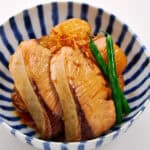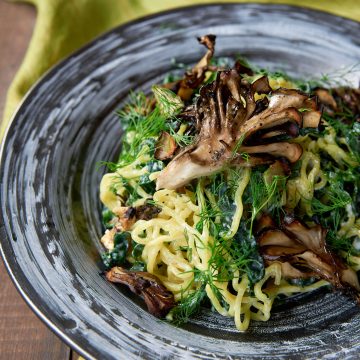
Until recently, I regarded hummus as an unremarkable dip served at parties with dried out flat bread. It wasn't until I had an opportunity to visit Tel Aviv a few years ago that I had really good hummus. Indulgently creamy and velvety smooth, with a deep nutty flavor and subtle lemony zing, this was not the bland beige paste that comes in plastic tubs.
It was on that trip that I came to the realization that hummus makes for a fantastic meal, especially when topped with ingredients like egg, fava beans, mushrooms, or onion. For this version, I've caramelized the onions. The sweetness and golden onion flavor balances the creamy, nutty hummus, while adding an additional layer of flavor somewhere between the tahini and lemon.

Devoured with hot pillowy pita bread and a side of olives, there are few things more satisfying than hummus when you're hungry on a hot day. I've since found a number of decent Hummus places here in New York, but at seven bucks a bowl, it's always seemed a bit pricey for what is essentially a puree of chickpeas and tahini. Lately, I've been even more conscious about my food budget, and it occurred to me the other day that I haven't had hummus in months.

Walking through the shiny new Whole Foods in Tribeca, I thought about the challenge I put forth to the food blogging community earlier this week, and wondered how many hungry mouths it would help feed. At an average cost of twenty five cents a meal, the World Food Program feeds tens of millions of starving people every year.
As I reached for a $3 tub of Greek yogurt I realized it could pay for 12 meals and I stopped myself. In the produce section I paused for a moment in front of some brilliant orange lobster mushrooms that cost about 120 meals each, and then moved on. Seeing the grocery store in this perspective really changes the way you think about the things you put in your cart. I ended up leaving with enough food for several meals (including this hummus), and yet I managed to spend about half of what I normally do.
This hummus costs roughly $4 to make. I also made my own pita bread which adds about $1 to the cost for a total of $5 for this meal, which will easily feed 4 people. Since I typically spend about $15 on ingredients per meal, I'm donating $10 to the World Food Program through Blog Away Hunger
TIPS: _This hummus is much smoother and creamier than the stuff sold in stores. I get this texture by adding back some of the liquid the beans cook in which makes it a little looser. The cooking liquid actually has a lot of flavor and I'm thinking about experimenting with it as a vegetarian stock. You can adjust the amount of liquid you add if you like it thinner or thicker.
Chunks work well in dishes like guacamole, but I prefer my hummus smooth, so I really let the food processor go to work on it. Make sure you use good quality olive oil and don't be shy with it; it keeps the hummus moist and gives it a nice creamy mouth feel. Serve it with my Muhammara for a delightful contrast in texture.
This recipe first appeared on norecipes.com but due to its age I've moved it here to my personal recipe archive. Check out the full No Recipes Archives for more older recipe or check out some of my favorite recipes.

Units
Ingredients
- 225 grams dry chick peas (about 3 cups cooked)
- ½ cups tahini
- 2 tablespoons lemon juice
- 1 medium clove garlic (grated)
- 1 teaspoon salt
- ½ cups aqua faba (chickpea cooking liquid)
- 1 large onion
- olive oil
Instructions
- Wash the chickpeas and pick out any foreign objects. Add them to a pressure cooker and cover with a few inches of warm water. Affix the lid and let them soak for at least an hour. Lock the pressure cooker, set it to the high pressure setting (see your pressure cooker manual for specific instructions), and turn the heat on to high. Once you hear the cooker start to whistle turn down the heat to maintain a gentle whistle and cook for 60 minutes. Turn off the heat and let the pressure cooker come down to room temperature on its own. Your chickpeas should now be very tender. Don't worry if they're coming apart because it will all get blended together anyway.
- Add the cooked chickpeas, tahini, lemon juice, garlic and salt to a food processor and blitz until smooth. Add the cooking liquid from the pot to the food processor a little bit at a time until the hummus is soft but not runny (about ½ C of liquid should do it). Continue to process for about 7 minutes in the food processor, or until the hummus is velvety smooth.
- To make the caramelized onions, quarter the onion lengthwise then slice it as thin as possible against the grain (like you're making onion rings). Add a generous splash of olive oil(1+ Tbs) to a frying pan along with the onions and a pinch of salt. Cook over medium high heat, stirring regularly, until the onions just start turning brown. Turn down the heat to medium low, continuing to stir until the onions reach a golden brown color all the way through (this will take 15 to 20 minutes).
- To serve the hummus, spread half of it into the bottom of a shallow bowl in a swirly pattern. Drizzle a good helping of olive oil over the hummus allowing it to collect in between the swirls. Pile half the caramelized onions in the center of the bowl. Repeat with a second bowl or store the hummus and onions for another meal. Garnish with some minced parsley and paprika and serve.

















Comments
No Comments